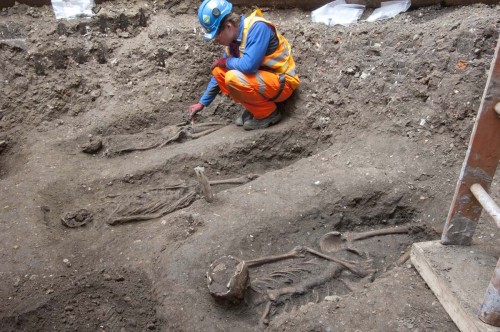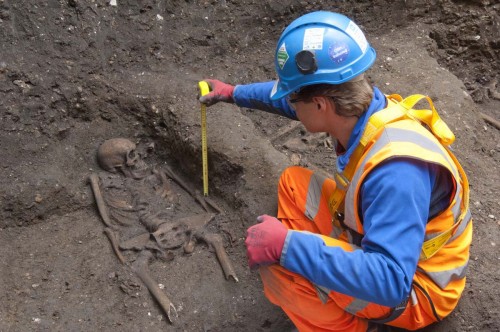The discovery by Crossrail workers of skeletons near to the Barbican last year have been confirmed as being victims of the Black Death.
Twenty-five skeletons were uncovered in London’s Charterhouse Square near Farringdon during Crossrail construction works in March 2013. It provided the first evidence of the location of London’s first Black Death emergency burial ground established in 1348.
Due to the burial ground’s historical importance to London, an exceptional amount of research analysis has taken place on the skeletons to understand the life and death of Londoners affected by the Black Death.
From the skeletons’ teeth, scientists have found traces of the DNA of the Yersinia pestis bacterium which was responsible for the Black Death plague, confirming the individuals had contact with the deadly disease prior to their death.
There also appeared to be two phases of burials, in 1348-50, followed by a later period dating from the early to mid 1400s.
The site of the burial is just outside the city walls, and the site is named after the Charterhouse that was built next to the burial site to pray for the dead that were buried there. That former monastery is still there, largely hidden behind high walls, and you can book occasional tours to have a look around inside.
A further dig in July of this year will seek to confirm separate geophysics results which suggest that there could have been a chapel, in the middle of Charterhouse Square itself.
That picturesque little park with high cooling trees conceals a very dark history.
Crossrail Lead Archaeologist Jay Carver who is heading up the research, said: “ Historical sources told us that thousands of burials of Black Death victims were made in the 14th Century in the area that is now modern day Farringdon, but until Crossrail’s discovery, archaeologists had been unable to confirm the story. Ancient DNA work is complex and still in development but the results do confirm the presence of the deadly plague bacterium preserved in the teeth.”
Scientists have analysed the bones and the Isotope levels in the skeletons’ bones and teeth to gain an insight into the birth, life and diet of Londoners during the 14th and 15th Centuries. The results showed that:
- Many of the skeletons appear to suffer signs of malnutrition and 16% had rickets.
- 40% of the those tested grew up outside of London possibly as far north as Scotland – showing that 14th Century London attracted people from across Britain just as it does today.
- The later skeletons from the 1400s had a high rate of upper body injury consistent with being involved in violent altercations.
- One individual had become a vegetarian later in life which is something a Carthusian monk would have done during the 14th Century.
- Research is consistent with the burial ground being used by poorer Londoners.
- High rate of back damage and strain indicating heavy manual labour.
There will be a documentary on Channel 4 next Sunday (6th April) about the discovery. In the meantime, why not watch Quatermass and the Pit as a timely reminder of what happens when you dig up bodies during a London Underground tunnel excavation.
More articles and photos from the Crossrail tunnel construction sites here.









